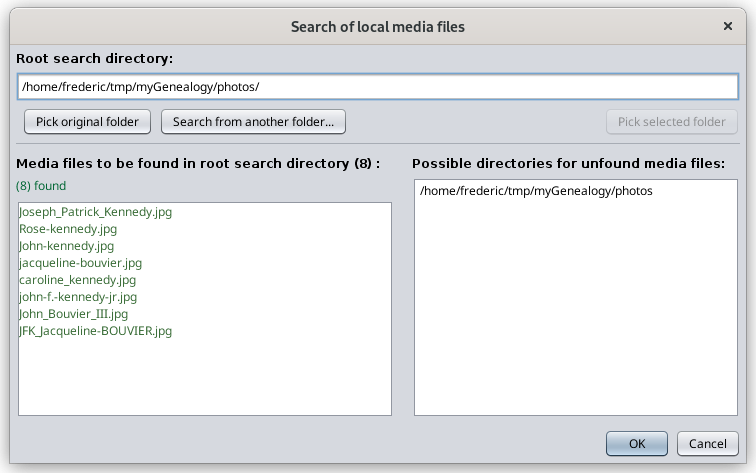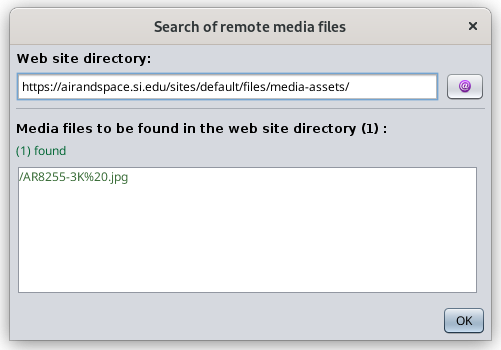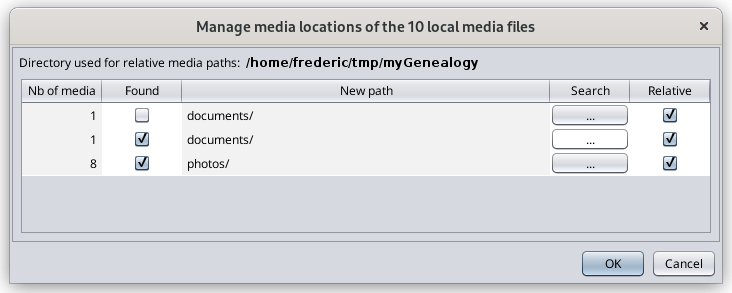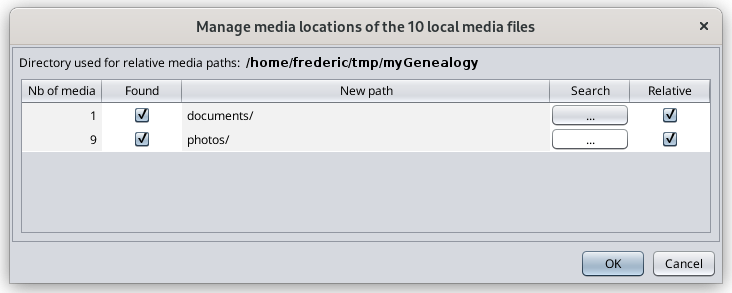Manage medias files
This window is a Media Manager that lets you ensure that all media files used in your genealogy exist, either on your local disks or on the Internet, that they are used, and that they correctly link to your Gedcom file events.
A typical situation where you need to use this tool is if you have modified your photo folders for instance, or if you have just migrated your genealogy from another software.
Description
The windows is made of 2 areas:
- A statistics area providing the number of files by category, the full directory name of the location of the Gedcom file, from which relative path files are to be considered, and a button to see all the media files.
- An edition area where you can make 3 types of modifications and undo them
- Swap paths from relative to absolute and vice versa
- Edit folder's paths
- Download remote files from the Internet to your local disks and change the link accordingly in your Gedcom file
Statistics
The indicators have the following meaning.
- Total number of files is the total number of physical file references in your Gedcom file, either on your local disks or on the Internet. File references are written as FILE properties. Empty file names are included in this number. This number adds up local and remote files below. It also adds up to files attached to media entities and media properties.
- Number of distinct files is the number of distinct physical files referenced by the genealogy. It can be lower than the number above. Indeed, the same physical file can be indicated in multiple FILE properties.
A warning is displayed if some physical files are referenced more than once. It is inefficient because changing the file name on disk will require you to update the genealogy in more than one place. Click the "Show all files" button to identify which are these "duplicate" files and consolidate them into the same media entity.
- Local files: this is the number of files physically located on your disks (hard drive, USB keys, etc). It is made of relative path files and absolute path files.
- relative path files start from the location of the Gedcom file. The path string does not start with "/" or "C:\" for instance.
- absolute path files start from the root disk folder, usually "/" or "C:\".
- Remote files: this is the number of physical files located somewhere on Internet web sites.
- A Check existence button lets you check if all remote file really exist. If you click this button, Ancestris will scan all remote files and try to access them. This can take a long time depending on your Internet connection and the response time of the various web sites involved. If there are no remote files in your genealogy, this button will be disabled.
- Files attached to media entities: the file references (FILE) are sub-properties of media entities, and can therefore be used as references multiple times throughout the Gedcom file.
- Files attached to media properties: the file references (FILE) are sub-properties of media properties, and cannot be used anywhere else in the Gedcom file.
The next information is the full path name of your Gedcom file, from which relative paths will be starting.
Finally, the "Show all files" button opens the Media viewer with all the pictures of the genealogy.
This Media viewer is the same viewer as the one accessed from the Cygnus editor with one difference: the list of pictures in Cygnus is limited to either events media or sources media.
Edition
This section includes various elements:
- A table listing all folders used by the genealogy, split into different lines depending on whether the included files are found or not, local or remote, attached to entities or properties, relative or absolute.
- Above the table are filters to only display certains lines.
- To the right-hand side of the filters are the Clear and Select buttons to help you select and unselect lines more quickly. You can also select lines using the mouse.
- Actions field and buttons below the table to make global changes
Changes made in this editor are made in the Gedcom file and can be undone either via the undo button below, or using the Ancestris main menu bar undo/redo buttons.
Folders table
Each line in the table correspond to a group of files within the same folder and with the same attributes, found/unfound, local/remote, entity/property, and relative/absolute.
- The columns on the left-hand side are for information only.
- Files: number of physical file references included in the mentioned folder, that have the found, local and entity attributes indicated
- Found: checked if files in this group are found, otherwise they are unfound
- Local: checked if files in this group are local, otherwise they are remote
- Entity: checked if files in this group are attached to entities, otherwise they are attached to properties
- Folder: folder name. This is the FILE property value of the Gedcom file.
- The columns on the right-hand side let you make some modifications on the folders and identify unfound files in particular.
- Relative: checked if files in this group have a relative path, otherwise they have an absolute path. Clicking on the checkbox changes this attribute. It swaps from relative to absolute path and vice versa.
- Action: this button opens a window which lists all the files included in this group to help you search for them when they are unfound. The window differs if the group is made of local files, or remote files. See below an example of each window.
-
Selection: click on the checkbox to select or unselect the line. The Replace button and Download button will apply to this selection.
This is an example of the Search window for local files. An explanation of this window is provided in the corresponding usage section below. 
This is an example of the Search window for remote files.
In this "Search of remote media files" window, the Internet button opens up your browser on the corresponding web site directory.
In the list of media files, clicking on a file will try to open it in your browser. The files are listed in green if they could be accessed, in red otherwise.
Filters
- Unfound:
- Local:
- Remote:
- Relative:
- Absolute:
- Selected:
Clear and Select buttons
- Clear
- Select/Unselect
Action field and buttons
- Replace subpath field:
- Replace button:
- Relative button:
- Download button:
- Undo button:
Usage
XXX
Problem of 'unfound files'
Where can the problem come from?
1. Have you renamed your media folder or your media file?
If your photo is in a /mygenealogy/photos/MyPicture.jpg file and your Individual entity references this photo in a FILE tag with value of /mygenealogy/photos/MyPicture.jpg, then the link is valid. Everything is fine.
Now, if you rename your photos directory or just the media file, it may generate a broken link. For instance, if your photo file becomes /mygenealogy/media/MyPicture.jpg with media instead of photos, Ancestris will not find it because it still thinks it is in the "photos" folder, not "medias".
This is enough to break the link. The Media Manager above will consequently display your photo as an unfound media.
2. Have you moved your Gedcom file?
Rather than renaming a media folder or a file, you may have just moved your Gedcom file.
Relative position between your Gedcom and your media
- If your media files are described in relative position with respect to your Gedcom file, the link is lost, because in this case you would have had to move your media files at the same time as your genealogy Gedcom file.
- We recommend that you only specify your media in relative position of your Gedcom file location as this allows you to move your files without renaming the links.
Absolute position between your Gedcom and your media
- If your media files are described in absolute position, the link to the media is not lost because it is not using the position of the Gedcom file.
- But the downside is that if you move your genealogy to a USB key, for example, your media will have remained on your hard drive and you will only be able to see your media if the USB key remains on your computer.
- If it is to show your genealogy to one of your relatives, you will have to move the media to the key. But suddenly the links will be broken because the Gedcom file will think that they are still on your computer. You will have to rename them by one in Gedcom or else you use this Media Manager tool.
3. Have your files been deleted?
Another possible reason for a loss of link between your Gedcom file and your media files can also come from file deletions on the disk. It's more annoying because you have to already get hold of those files before continuing with the media manager or else removing the links in the Gedcom file.
The Media manager does not remove the links, it just renames them.
4. Case of remote files
In the case of remote files, it can just be due to the fact that the web site has been reorganised, ahs changed domain name or any other web site structural modifications.
Resolution of the 'unfound files' problem
If you are confident that your media files are somewhere on your computer, click the button at the bottom of the window similar to this one.
The following window appears.
This window first gives the name of the directory where the Gedcom file is located. Relative paths will start from there.
Underneath, in the table, you will see the list of all the different paths found in the Gedcom file (all the FILE tags).
In the example above, out of 10 media files, 1 media is not found in the "documents" folder, 1 media is found in this same folder, and 8 media files are found in the "photos" folder. All media file links are specified in the Gedcom file in relative position from the Gedcom file location.
On each row, you can click on the "..." button in the Search column to locate the corresponding media files.
In the example above, the following window appears if you click on the first button with the unfound media file.
This window will help you find the lost file.
Ancestris will search for the file in all directories within the root directory indicated at the top. You can change it using the "Other..." button, or 'Original" to go back to the original root directory.
The files to be found are listed in red in the left column. Otherwise, they will appear in green. In this example, the file to be found is "Herald_Tribune.jpg"
The directories where the files exist are in the right column.
- If no directory appear on the right, it means the file does not exist in any of the folders under the root directory indicated on top. If you change the root folder and still no directory appear, it means the file is either deleted or its name has changed. You would have to use your file explorer on your PC to identify its new name or else recreate the media file.
- If one or more folder is listed on the right, select one of them. The Selection button should becomes available. Press it to set the found directory as the new root directory. You can also directly double click on the directory to be selected.
For instance, below I changed the root directory to myGenalogy and the photos folder appeared on the right. I pressed the "Selection" button and then, the file on the left becomes green again, and the root folder was updated to "Photos".
The file had apparently been moved from "Documents" to "Photos". If I prefer to move it back to Document, I can do it using my file explorer after cancelling the action here. Otherwise, just click OK.
You will be back to this window below,where the counters have been updated, the unfound file is no longer unfound.
When all the Found boxes are checked, you have found all the lost files.
Click OK.
The Media Manager will show this:
At this stage, no modification has been made to the Gedcom file.
If you are OK to proceed, press OK. Otherwise, press the middle button "Cancel request".
Customization
XXX








